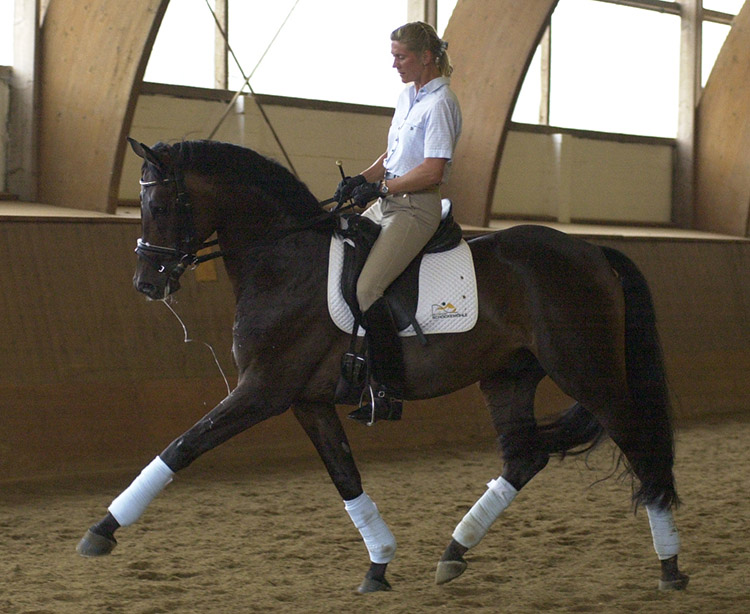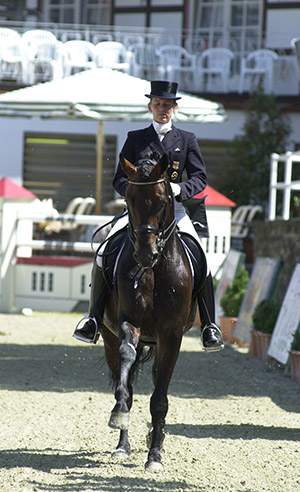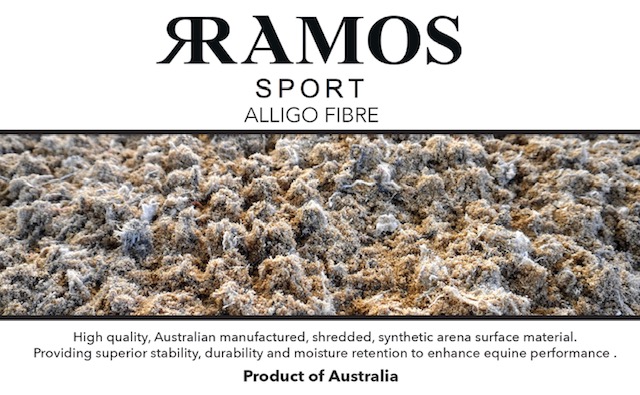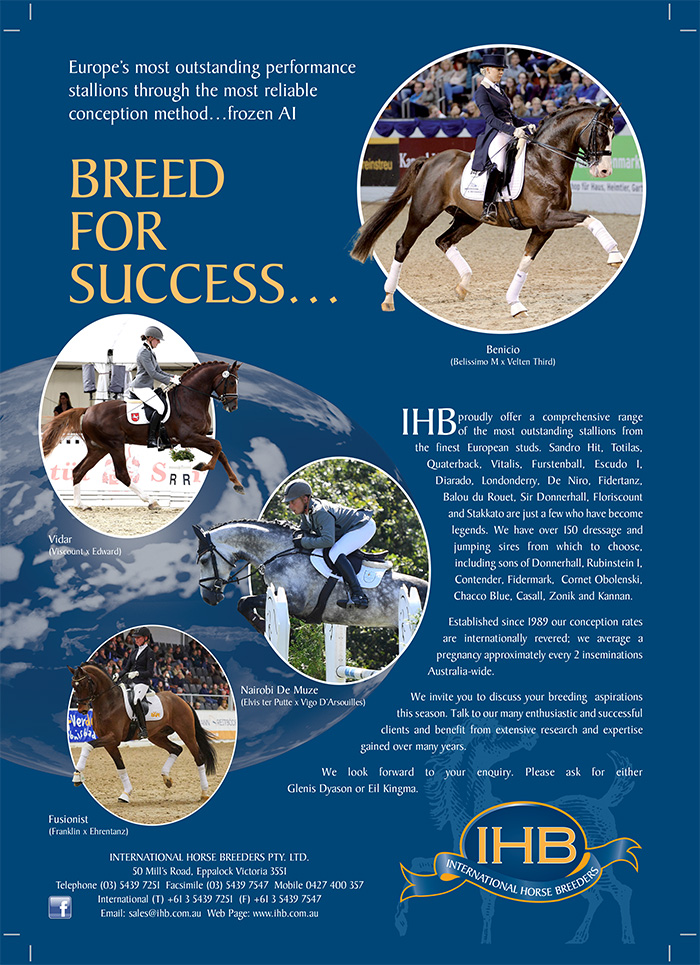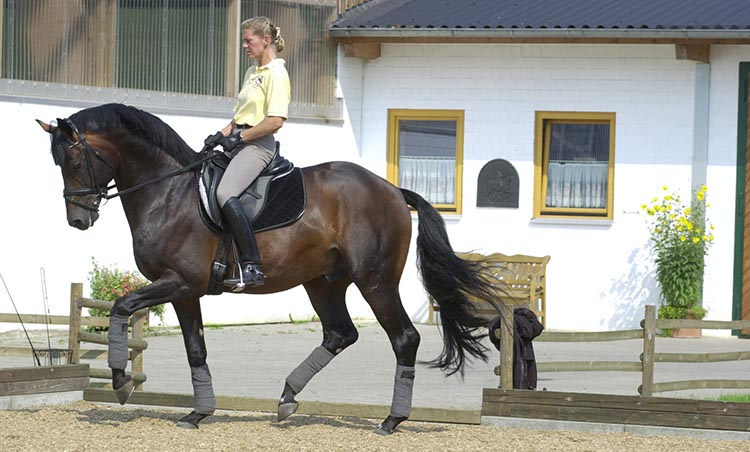
It is the subject of endless debate – just what is the best position for your horse’s neck, we thought it would be interesting to ask German professional, Martina Hannöver her views on this vexed, and vexing, question…
Story by Chris Hector & Photos by Roz Neave
For Martina, deep and low is the essential first step:
“We need the neck to stretch down for the warming up, right in front of the saddle so the back can come up and the hind legs can come under and this way we are able to connect the hind legs.”
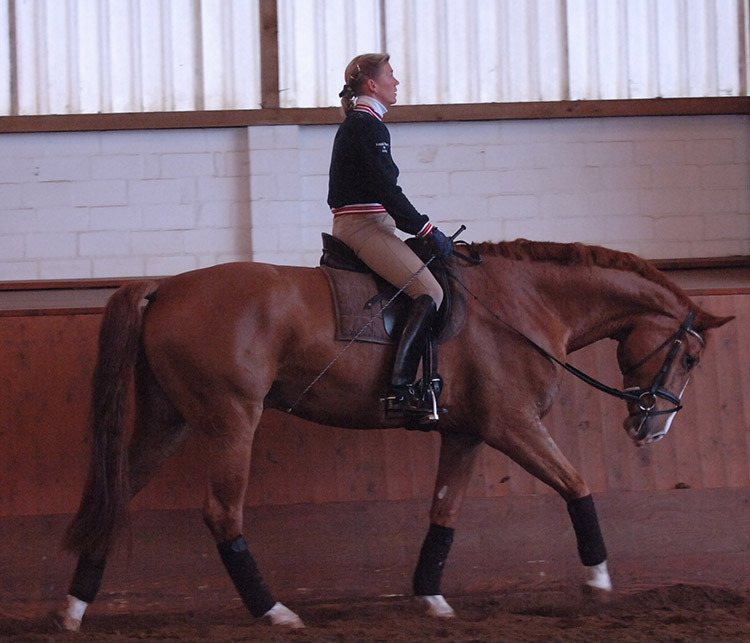
“I like my horses to go down right in front of the saddle and follow my hand as it goes forward, and then I can then check if the horses are honestly loose in the back because if I push with my legs and I get something resistant in my hand, they are not honestly there and not ready for work.”
How do you train them to go deep or do you find that horses naturally want to do it?
“They are all different, different breeds, different types: some of them they love to go deep and round, some feel like they have been in a scuba diving course for many years, they love it down there – and some, you have to ask. This is why we have to work differently with the neck with different horses.”
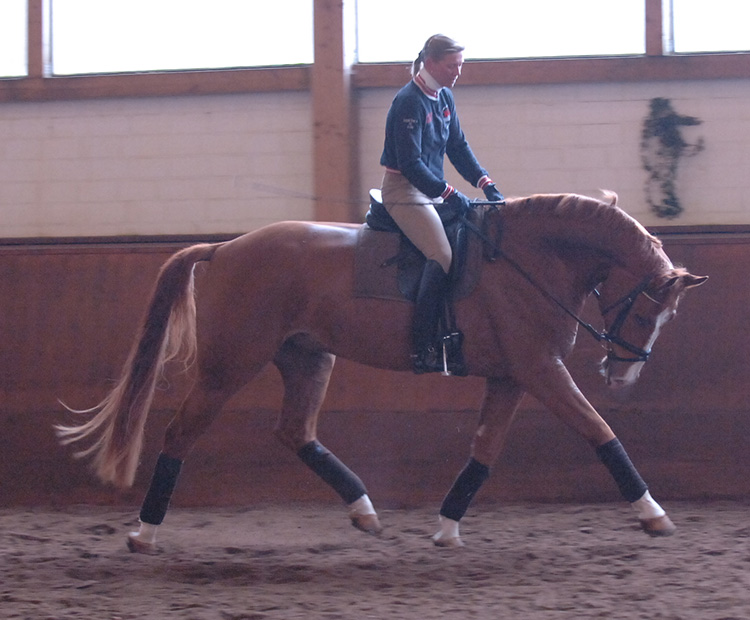
“In the warm up it is very important that we check that the horse is loose and soft and round, that we can do the basics like walk, trot canter, and to check if the horse is able to carry our weight. If we do this with the neck up and with a short rein, we don’t ask them honestly if they are ready. On the long rein we have nothing to hold onto and we just have to balance ourselves without pressing our legs on the horse, just sitting quietly with long legs in the deepest point of the saddle.”
You started off working with your new Weltmeyer gelding (pix above), the five-year-old Womaniser, does he have some issues going long and deep?
“He has only been with me for five weeks, and it is not really his favourite thing to do, it is more about calming down and getting him deep and low and following my hand. The way he is working he is too hard against my hands, he wanted to work in a higher competition frame, but he is not balanced this way. When I asked him to work on two tracks, for example, to come away from the wall, he is not balanced; he is falling down in front or losing his rhythm. He is not trained to work deep and low, he has been worked in a more competition way of going. It is all about training. It is like a child, you have to teach them how to walk, trot, canter.”
With him, how do you encourage him to have a longer, lower neck?
“Transitions. First I start with trot and when I feel he is following my hand a little then I push him a little more. Because he has a super active hind leg I think it is a problem for him, there is so much activity that to carry his own weight makes him stronger in the front, stronger in the hand. As I said, what we have to do is connect the hind legs, it all must fit together. In this case the activity from the super active hind leg is getting in the way of the looseness and suppleness.”
If the chestnut gelding found the long and low business a bit of a chore, it was quite different with the brown Sandro Hit five-year-old mare, Soleil:
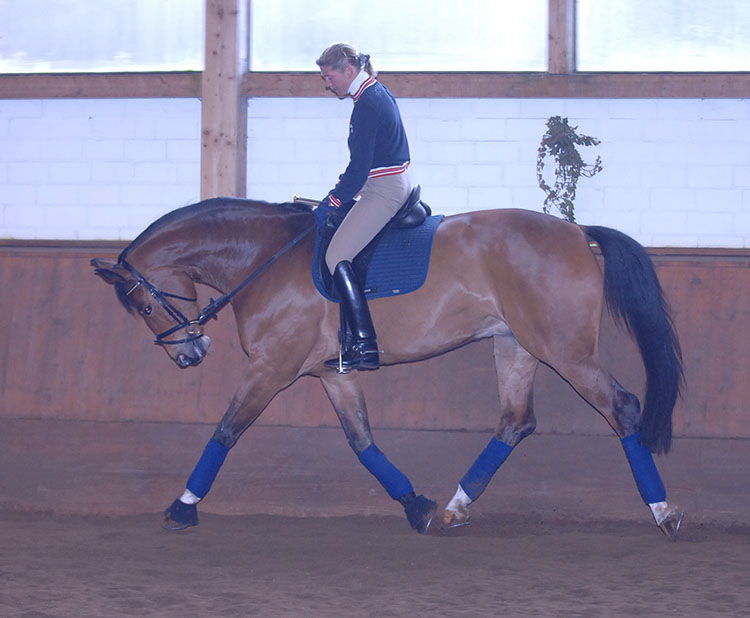
“She has the looseness on her own, so therefore I warm her up in a normal way, with the neck deep and round, walk-trot-canter, some transitions, then I take the neck more up and ask for more engagement from behind, loosening the shoulder with the neck up naturally, without holding or pulling them.”
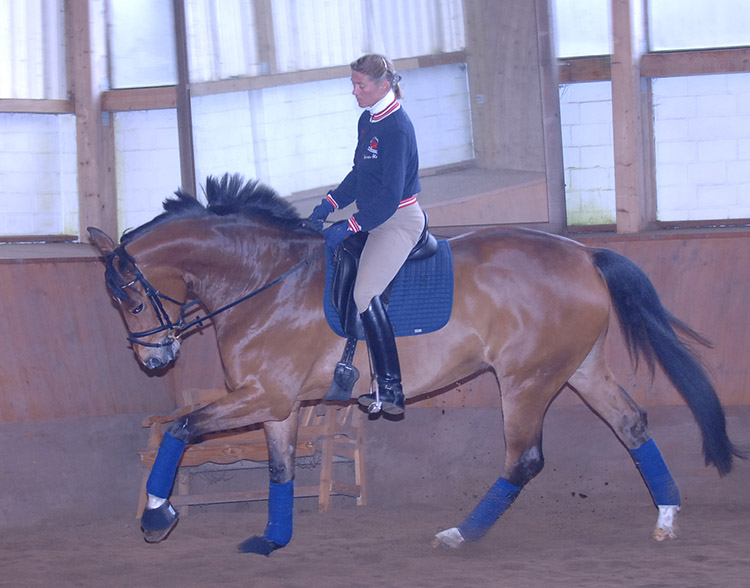
Martina says:
“This is Soleil my Sandro Hit filly. These are two totally different horses. With the Weltmeyer it is a little difficult to start early in canter with him. He’s a little bit stiff and not loose like this one – she has a lot of suppleness, and for her it is very good to go in some transitions – trot / canter – canter / trot, I let her stretch deep and round, go forward in the canter because she loves to collect too much by herself in the canter. So I think about these things in the warmup.”
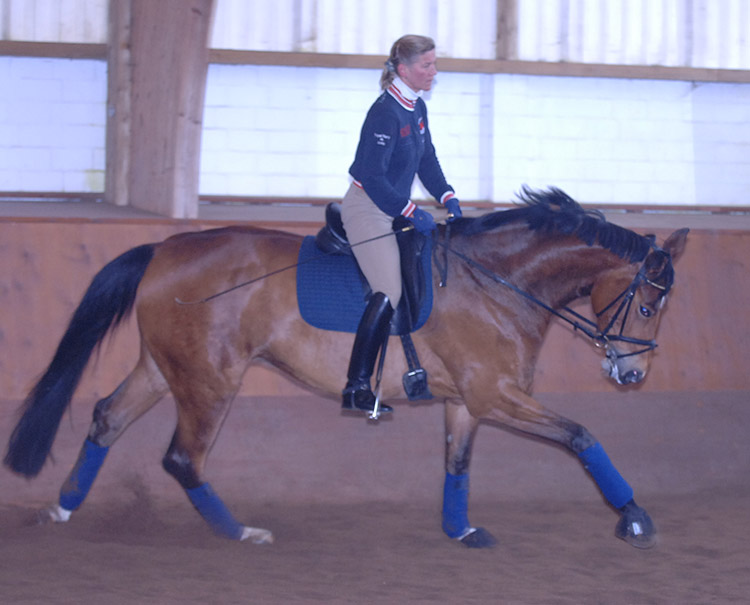
What exercises will you do in that deep position?
“Half pass, shoulder in, even a counter canter. Also if the horse is too spooky I ride them deeper and keep them down there without holding them, it is the natural balance I am trying to achieve with the longer lower neck. As soon as I shorten my reins, they come up with the poll and I make myself a little stronger in the upper body and then they are there.”
Once you have them in that position, how do you maintain it without jamming them?
“I try to give them little half halts, half a centimetre, take a little with the bit, and the rest comes from my seat and my upper body if I want them a little more collected.”
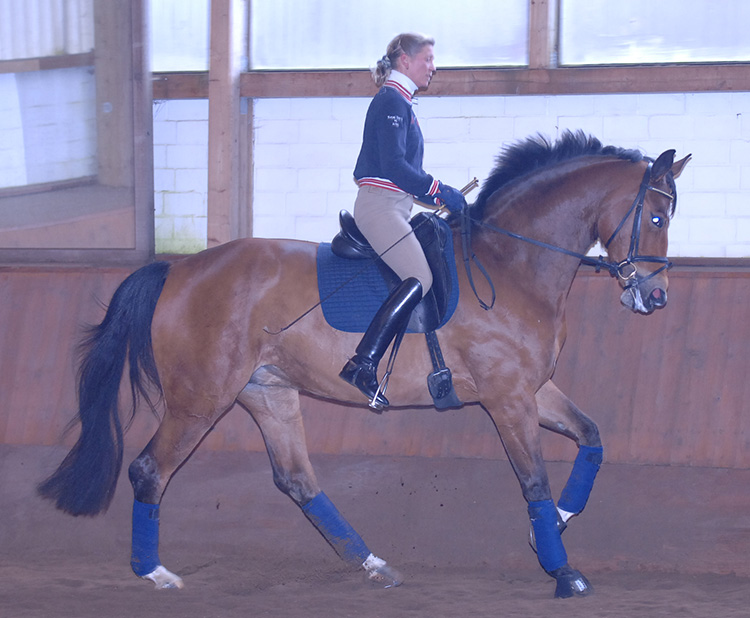
Soleil counter canter:
“She is nice and up in the poll. I have much shorter reins. I’m not sitting too much in her back because I am trying to make myself a little bit lighter. It was just directly after the corner and she is only five. For her to balance in counter canter is not super easy, and especially at home, I don’t help her a lot. I train them to do it on long reins. I train them to do it up at the poll. It is not usual for a horse to counter canter, and I use that to teach them to balance and carry their weight, just like they do in the normal canter. With her I really like the way she is so good in the back, and so good in the hind legs. She’s not trying to go into travers or anything like that – with most of the other horses when they start counter canter they need a little shoulder fore, but not with her. They are trying not to carry enough weight with the inside hind leg, and with her I don’t have that problem. With her I only have the problem that she likes to come too much backwards in the counter canter, and she is waiting for the simple change – so I’m going forwards and backwards with her in the counter canter, and then back on the diagonal, without a simple change and just let her go to trot…”
Next Martina works with a Rubinstein son
One of Martina’s favourites is the Rubinstein son, Remember Me. He starred a year or so back in Martina’s training the young horse series, and now after a life threatening illness, he is back in full work. Like his dad (who Martina rode to fame and glory) he is not naturally the most expansive mover…
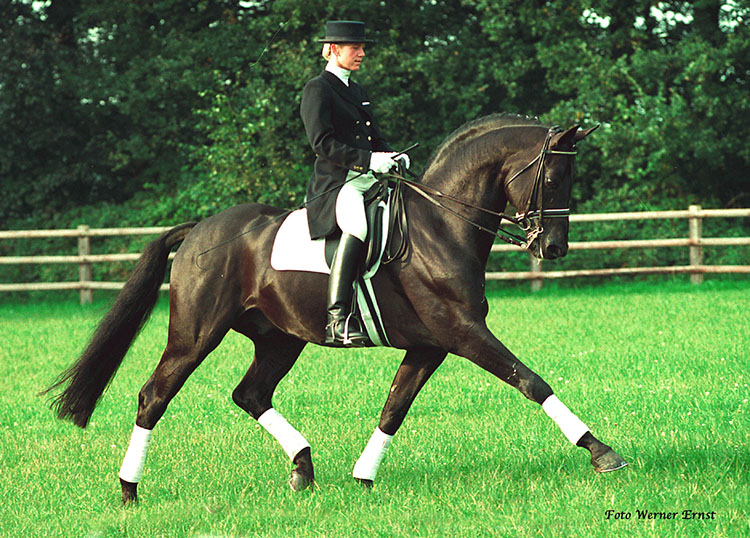
Martina and Rubinstein – Werner Ernst image
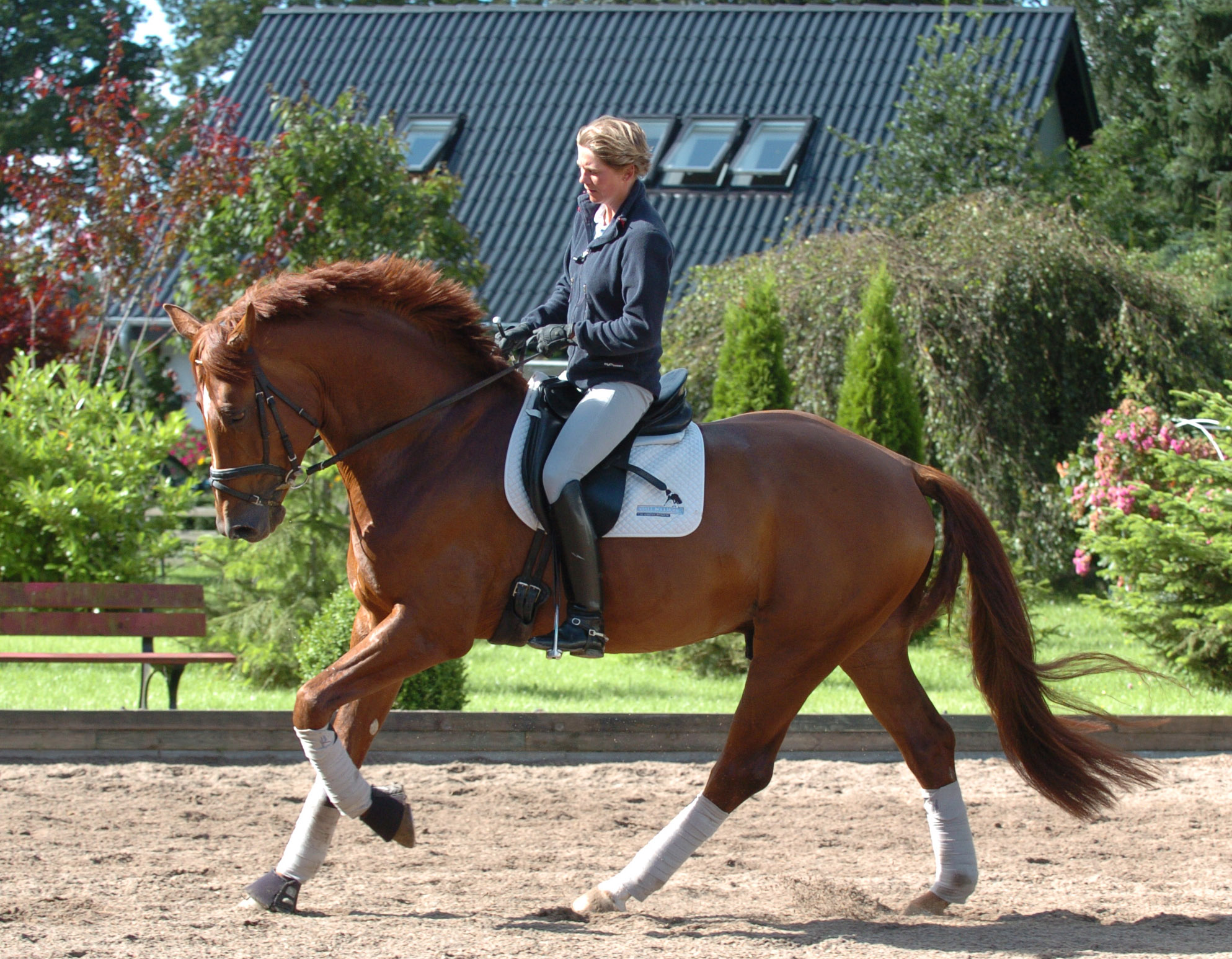
And Remember Me before he was sick
“He is by Rubinstein, some of the Rubinsteins have the problem that they put the head up there, it looks good but they don’t want to really give in with the neck right in front of the saddle and then you cannot build up the muscles in the back right behind the saddle, so with him going long and low is a little bit difficult, but he will learn.”
So how are you teaching him, what aids are you using?
“I am playing with the shoulder fore, as soon as he gives in, I give in as well, and I try tiny half halts to make him listen to me, not pulling back because then he gets short in the neck, behind the vertical, and this is when you can’t build up the muscles properly.”
How do you know when it is time to bring them up from their scuba diving lesson?
“If I can do sitting trot, and they carry my weight on a longer frame and I can do transitions, walk to trot, trot to walk then they are ready to come up more. But I also do exercises when they are deep and round because I think especially for the young horses it is a little easier to balance and to carry their own weight when they are a little deeper with the neck.”
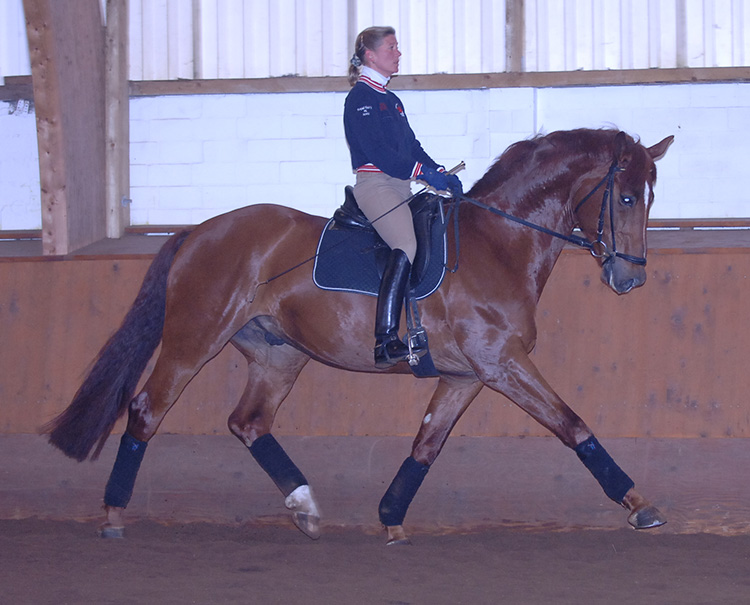
“In this picture he had been warmed up already, and was going really nicely, deep and round, and starting to carry my weight. So I go into sitting trot and took his poll more up, shorten my rein a little bit, and let him trot naturally, carrying my whole weight in his back. This is how I would start a typical working session with this horse. He prefers to go too high with his poll, all the time, and then he gets too stiff in the back. He needs to learn to carry his weight on his own, and to balance on his own. Before I got him, he had always been ridden up – they didn’t train him to go on a long rein, or to use the second track – they were more looking for ‘spectacular’ trot work. The horse was never relaxed enough. That’s what I noticed particularly on the lunge line, where the horse shows me that he cannot carry his own weight in the canter and he has a fantastic canter – but he was always going from right to left and left to right with the hindlegs instead of stepping under, and this was a sign from him. When I ride him he doesn’t do this because I can help him with my own weight, but when he’s alone he is not able to do this – and a five-year-old horse should be able to canter on the lunge line.”
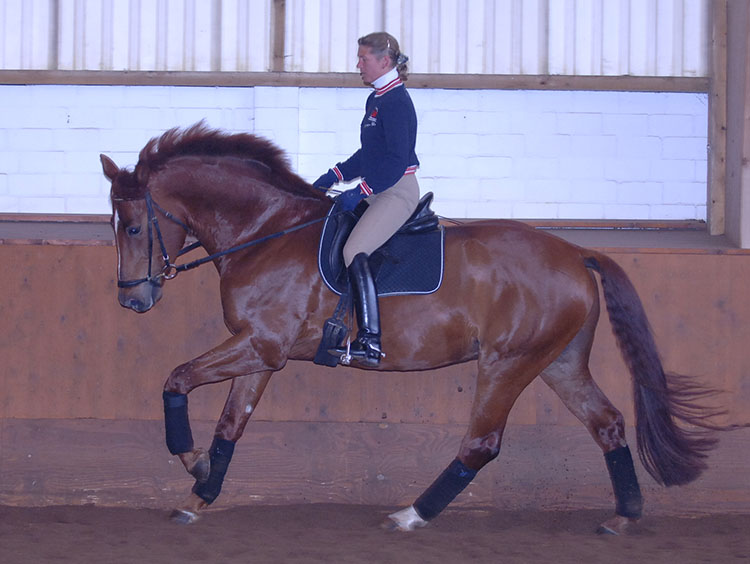
“We can see that it gets better and better the more his muscles get built up, and the more he learns to carry his weight and balance himself.”
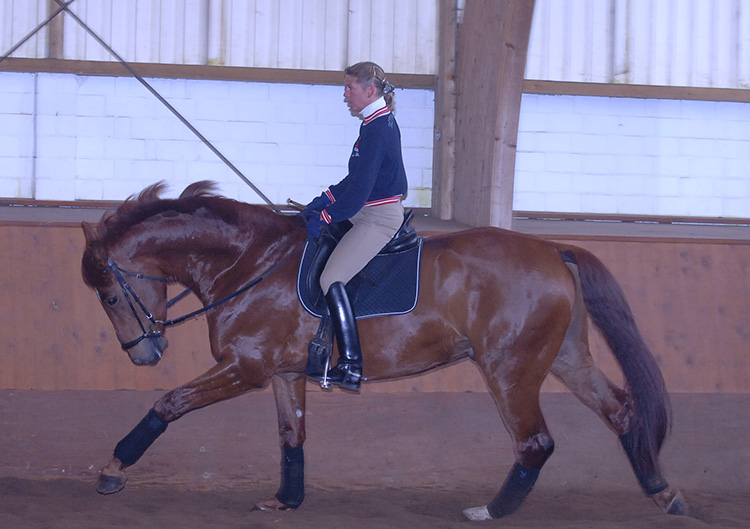
Martina tells us:
“Remmi has been back in training for two months. He lost a lot of muscle when he was sick. His problem is that he is typical for some Rubinsteins – he likes to put his head up and not go down with his neck in front of the saddle and stretch – so that he can build up the muscles behind the saddle. I’m working a lot on this, and with him I am doing many transitions, having him up with the poll and doing some little exercises but then going back down again to the stretching – working more on building up the muscles than the exercises.”
more follows
Breeding a dressage champion in Australia? International Horse Breeders has a great selection to top European Bloodlines, stallions like Total Hope – www.ihb.com.au
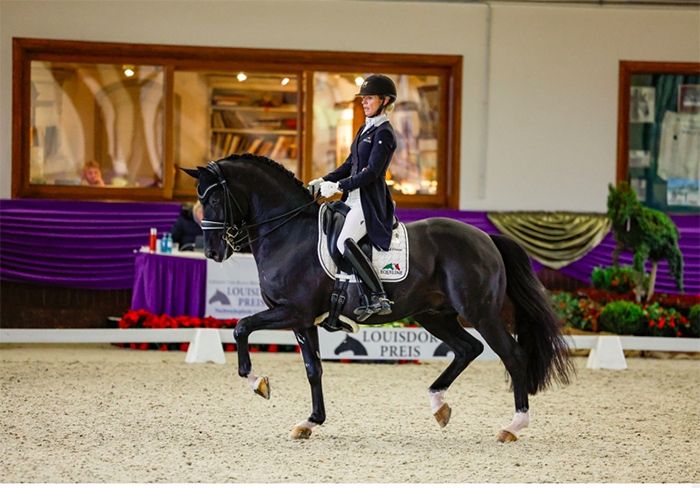
How are you asking with the seat and the upper body to collect?
“Good question. I have to think about that! I just do it. If you want to make them go more forward or come up a little more, you put the energy out of your upper body more forward then the horse lowers the hind legs and goes more up and more forward. You don’t have to pull to make them listen, if they are well trained, it’s little half halts. We also have the same problem if we want to teach the horse something – with this one he always had problems with the flying change, he was really lazy and late behind and not listening at all. So I had to make him a little bit sharper – it was not possible for me to give him the reins because he would have ended up in Hamburg or somewhere, so I had to get him there a little bit, and maybe at times then he was behind the vertical – but I always try to give so he can open up. Close the horse up a little, then open up again so the shoulder stays free. After he learned the flying changes, I said to him, ‘now we go back to the basics, and you have to listen to the half halts, and to my seat’ so we don’t end up with a tense horse. We need some pressure, some tension sometimes, but in-between we must always go back to the basics – so that we have a clear walk, and that we have the suppleness.”
There has been a lot of controversy over ‘rollkur’ – is this a technique that you like to use with your horses?
“I didn’t read all those articles. I am just trying to make my own way and be fair to my horses. If they are sometimes behind the vertical, then I try to open them up again. I’m not interested in this ‘great debate’ – we have a classical way in Germany. We have the basics and the scale of rhythm, suppleness, all that. If we look at the old pictures we have a big change in the riding, and also a big change in the breeding – so maybe there will be changes in the technique. But whatever you do, it must be fair for the horses, and the horses must be loose and must look calm. We all work with our own horses, and we must be self-critical, and ask, are we doing the right thing?”
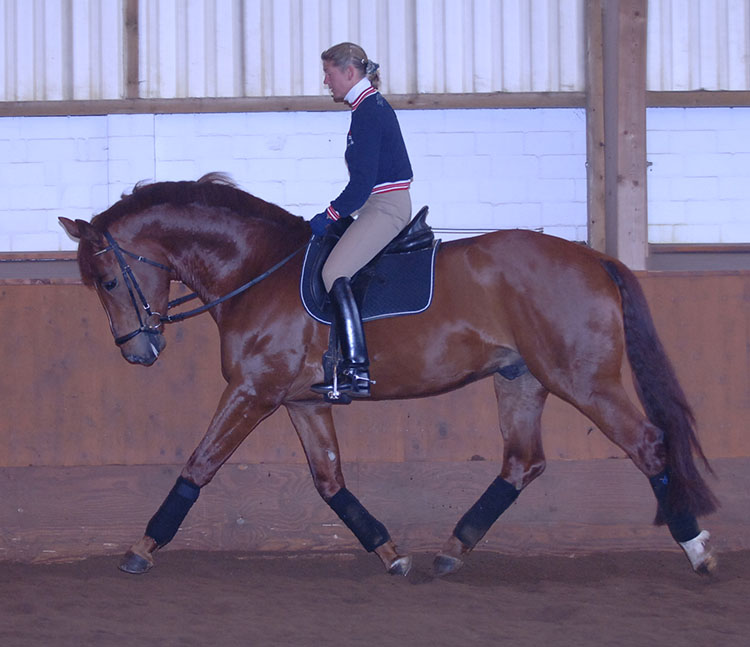
“Here he was ready to carry my weight, he was loose, and we started the working part. As you can see I have shortened the reins, and taken the poll more up. You can see how loose he is in the shoulder now. He really shows that he is a better horse than he looked in the loosening up part. He still needs this deep and round work – much more than the work he is doing here – this he can do on his own, but we will lose it if we don’t work on the muscles in the back. He has the potential to be really free in the shoulder and in the upper line, but to achieve this, he needs to be worked deep and round. He cannot carry this for a long time – if you rode him like this for 20 minutes, then he would stop working with his whole body, because he hasn’t got his energy and power back yet, but he will get it.”
Are the basic techniques you are using very similar to the techniques you learnt when you were working with Herbert Rehbein?
“I think I work more with younger horses. He worked more with the exercises at the Prix St Georges to Grand Prix level. I’m happy in my stable; we do the basic work with the young horses but also the Prix St Georges and the Grand Prix. My owners and my students understand what I am doing with all this work and it is not important to ride the higher movements every day. A one hundred metre sprinter is not sprinting 100 metres every day, he is doing gymnastics, conditioning training… the same with horses.”
There has been a lot of criticism of how the horses are shown in the so-called ‘spectacular’ way at the Bundeschampionate… if you qualify these horses to go to Warendorf, will you ride them in this spectacular way?
“The funny thing with these three horses, is that when they go to a competition, they show off so much more just by themselves. I don’t have to worry about putting more pressure into any one of them. In the test they are real fighters and they really want to show themselves off.”
Next an Argentinus son
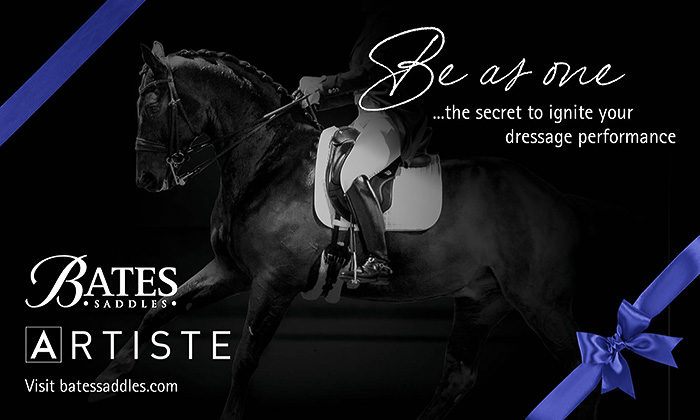
“Avalon is a five-year-old Argentinus out of the mother of Ratino. He’s 1.82m and he needed a longer time staying as a baby, because of his size and of his big movement – especially his big canter. He needed so long to learn to carry himself and to stay in canter because even a 20 x 60 arena is very small for him. Now I’ve got to the point where he can really carry himself, without me helping with the reins. Both of us more and more enjoy the work, and he feels much more comfortable with his size and his age now.”
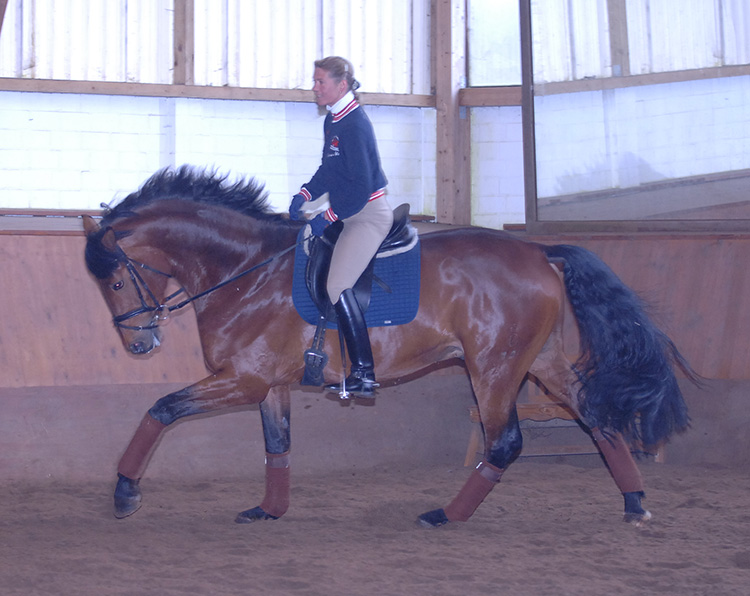
“He is five, but he is not ready like the Weltmeyer or the Sandro Hit for doing higher exercises. I don’t think we should focus on the Bundeschampionate with him because with his big trot and canter, it is too difficult for him. He can do counter canter, but it’s really not balanced yet. I don’t want to destroy my horse, he has plenty of time. He’s very sensitive and I like this, because he is a very big horse and if they are big and are not sensitive that’s a problem. With him I do a sitting trot and I take the poll up but just for a few minutes, then I feel he gets stiff and then I go out of the saddle again and play him a little bit deeper and go back until he feels comfortable, and then go back to the sitting trot again. It’s easier for him in canter but we still have to work on the bad parts and not just enjoy the good things.”
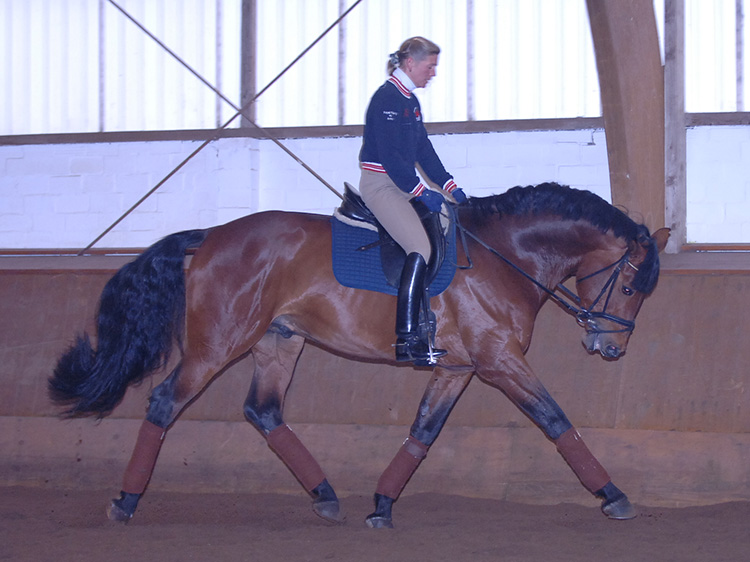
The horse tells you if it needs more time, less pressure?
“They show you so many things, and especially at age five and six years old you have to find out if they are really discussing something with you, or are they being naughty. It’s like kids, if you tell them to come home at 7 o’clock and they come at ten past, if you don’t tell them off, they come the next time at 7.30 then they come at ten. You always have to listen in to the horse, read the horse’s body – think about the muscles and the horse’s breeding and ask yourself, is the horse ready or not.”
“This horse has to work, and he is also a stallion, but he is not naughty. He is so short in the back and so tall, that he cannot do more. He is my own horse, and he can do very good half passes already in rising trot and shoulder in and flying changes. When we try to do counter canter – I thought about Rohdiamant, when he was four he was doing super flying changes then later he had problems, so I think the problem was with the counter canter at the Bundeschampionate. I’ll give him more time, I can wait until he is six, why not?”
“With his big trot and his short body he must work out how to trot. If you remember Ratino when he was five he got a little bit wide behind because he had no chance to go somewhere with his hind legs. He must fit in with his size and his body, like some big people they need a little bit longer.”
Ratino needed a bit longer
